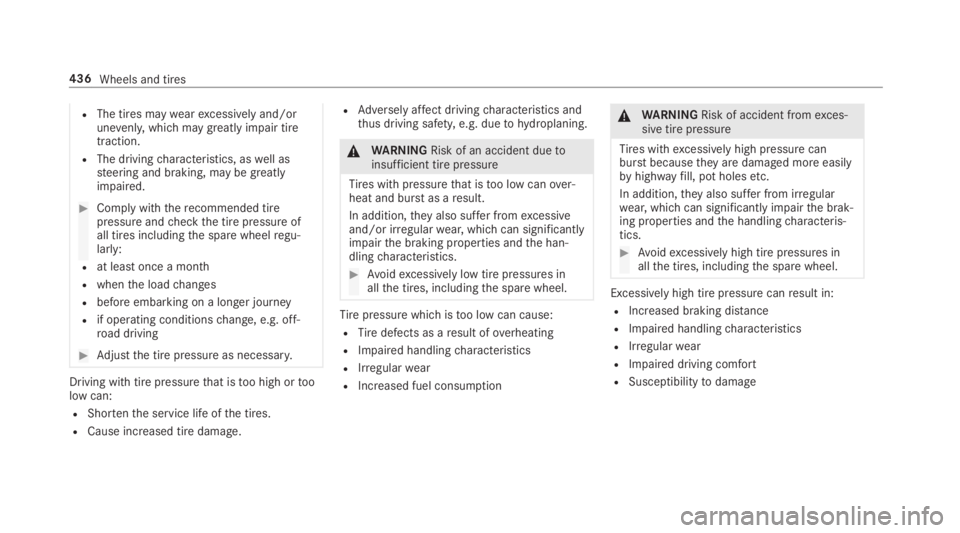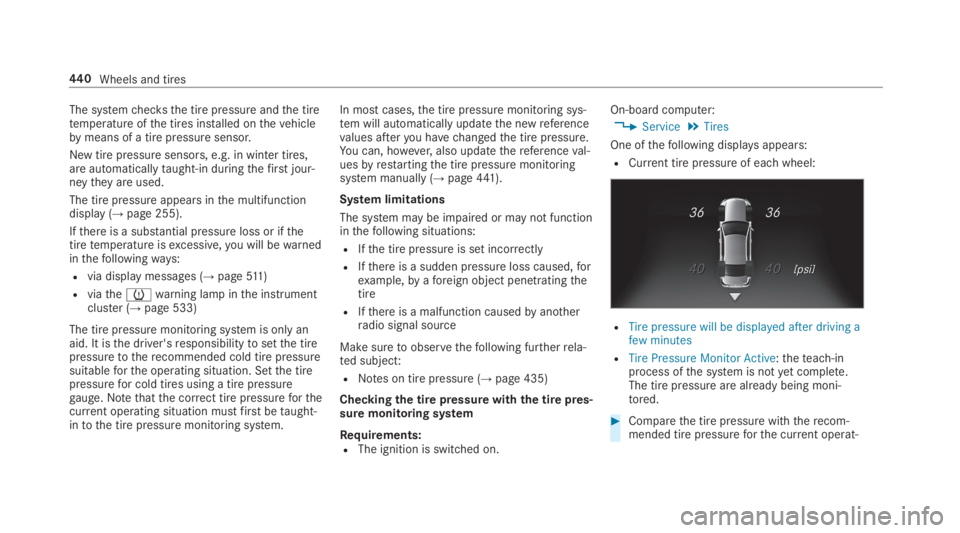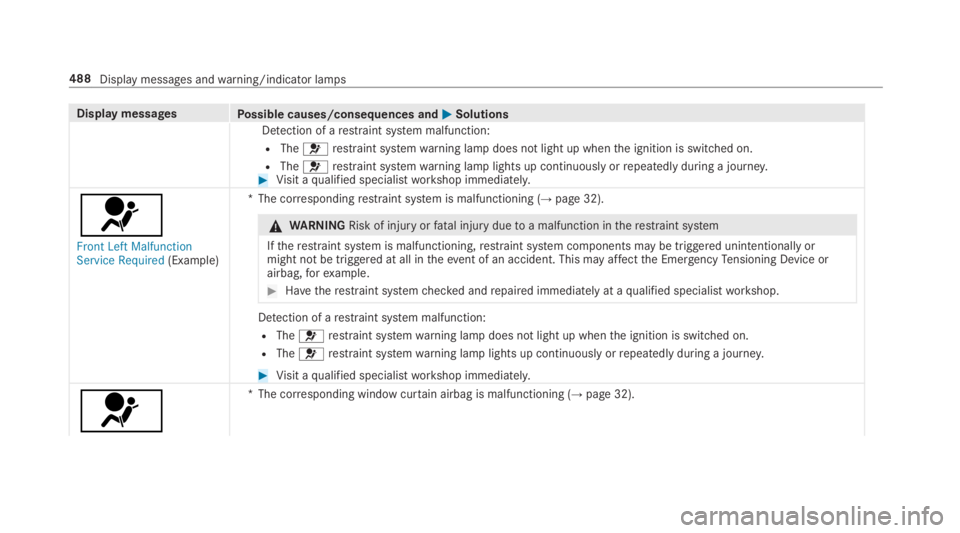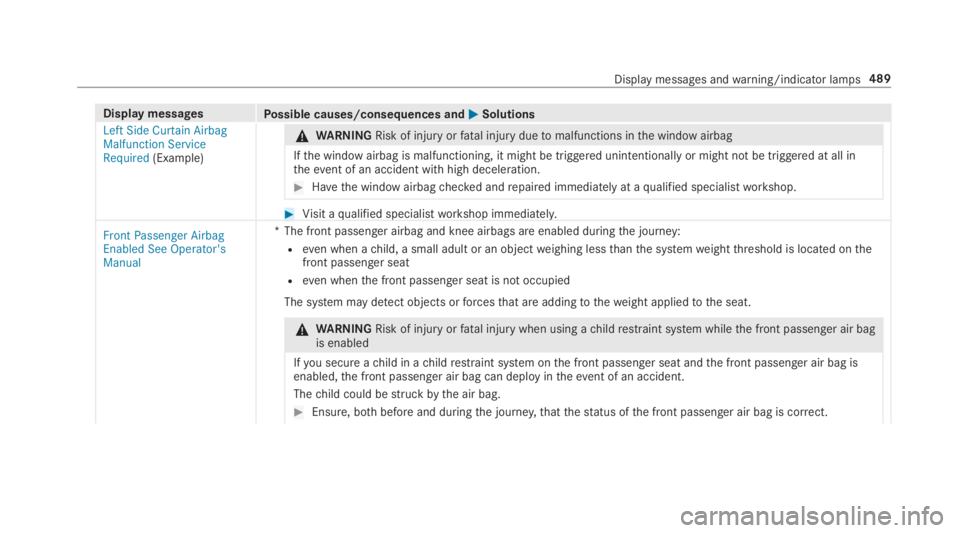2019 MERCEDES-BENZ S CLASS service
[x] Cancel search: servicePage 438 of 578

RThe tires maywearexcessively and/orunevenly,which maygreatlyimpair tiretraction.
RThe drivingcharacteristics, aswell assteering and braking, may be greatlyimpaired.
#Comply withtherecommended tirepressure andcheckthe tire pressure ofall tires includingthe spare wheelregu‐larly:
Rat least once a month
Rwhenthe loadchanges
Rbefore embarking on a longer journey
Rif operating conditionschange, e.g. off-road driving
#Adjustthe tire pressure as necessary.
Driving withtire pressurethat istoo high ortoolow can:
RShortenthe service life ofthe tires.
RCause increased tire damage.
RAdversely affect drivingcharacteristics andthus driving safety,e.g. dueto hydroplaning.
&WARNINGRisk of an accident duetoinsufficient tire pressure
Tires with pressurethat istoo low canover‐heat and burstas aresult.
In addition,theyalso suffer fromexcessiveand/or irregularwear, which can significantlyimpairthe braking properties andthe han‐dlingcharacteristics.
#Avoidexcessively low tire pressures inallthe tires, includingthe spare wheel.
Tirepressure which istoo low can cause:
RTiredefects as aresult ofoverheating
RImpaired handlingcharacteristics
RIrregularwear
RIncreased fuel consumption
&WARNINGRisk of accident fromexces‐sive tire pressure
Tires withexcessively high pressure canburst becausetheyare damaged more easilybyhighwayfill, pot holesetc.
In addition,theyalso suffer from irregularwear, which can significantly impairthe brak‐ing properties andthe handlingcharacteris‐tics.
#Avoidexcessively high tire pressures inallthe tires, includingthe spare wheel.
Excessively high tire pressure canresult in:
RIncreased braking distance
RImpaired handlingcharacteristics
RIrregularwear
RImpaired driving comfort
RSusceptibilitytodamage
436Wheels and tires
Page 442 of 578

The systemchecksthe tire pressure andthe tiretemperature ofthe tires installed onthevehiclebymeans of a tire pressuresensor.
New tire pressure sensors, e.g. in winter tires,are automaticallytaught-in duringthefirst jour‐neytheyare used.
The tire pressure appears inthe multifunctiondisplay (→page 255).
Ifthere is a substantial pressure loss or ifthetiretemperature isexcessive,you will bewarnedinthefollowingways:
Rvia display messages (→page511)
Rviathe�wwarning lamp inthe instrumentcluster (→page 533)
The tire pressuremonitoring system is only anaid. It isthe driver'sresponsibilitytosetthe tirepressuretotherecommended cold tire pressuresuitableforthe operating situation. Setthe tirepressurefor cold tires using a tire pressuregauge. Notethatthe correct tire pressureforthecurrent operating situation mustfirst betaught-intothe tire pressure monitoring system.
In most cases,the tire pressure monitoring sys‐tem will automatically updatethe newreferencevalues afteryou havechangedthe tire pressure.You can, however,also updatethereferenceval‐uesbyrestartingthe tire pressure monitoringsystem manually (→page441).
System limitations
The system may be impaired or may not functioninthefollowing situations:
RIfthe tire pressure is set incorrectly
RIfthere is a sudden pressure loss caused,forexample,byaforeign object penetratingthetire
RIfthere is a malfunction causedbyanotherradio signal source
Make suretoobservethefollowing furtherrela‐ted subject:
RNotes on tire pressure (→page 435)
Checkingthe tire pressure withthe tire pres‐sure monitoring system
Requirements:RThe ignition is switched on.
On-board computer:
,Service.Tires
One ofthefollowing displaysappears:
RCurrent tire pressure of eachwheel:
RTire pressure will be displayed after driving afew minutes
RTire Pressure Monitor Active:theteach-inprocess ofthe system is notyet complete.The tire pressure are already being moni‐tored.
#Comparethe tire pressure withtherecom‐mended tire pressureforthe current operat‐
440Wheels and tires
Page 443 of 578

ing condition (→page 437). Observethenotes on tiretemperature (→page 435).
%Thevalues displayed inthe multifunction dis‐play may deviate fromthose ofthe tire pres‐suregauge astheyrefertosea level.Athighaltitudes,the tire pressurevalue indicatedbya pressuregauge are higherthanthoseshownbythe on-board computer. Inthiscase, do notreducethe tire pressure.
Make suretoobservethefollowing furtherrela‐ted subject:
RNotes on tire pressure (→page 435)
Restartingthe tire pressure monitoring sys‐tem
Requirements:RTherecommended tire pressure is correctlysetfortherespective operating condition oneach ofthefour wheels (→page 435).
Restartthe tire pressure monitoring system inthefollowing situations:
RThe tire pressure haschanged.
RThe wheels or tires havebeenchanged ornewly installed.
On-board computer:
,Service.Tires
#Swipe downwards onTouch Control ontheleft-hand side ofthesteering wheel.TheUse Current Pressures as New Refer-ence Values?message is shown inthe multi‐function display.
#Press�vtoconfirmtherestart.TheRun Flat Indicator Restartedmessage isshown inthe multifunction display.
Currentwarning messages are deleted andthe�wyellowwarning lamp goes out.
Afteryou havedrivenfor afew minutes,thesystemcheckswhetherthe current tire pres‐sures are withinthe specifiedrange. The cur‐rent tire pressures arethen accepted asref‐erencevalues and monitored.
Make suretoobservethefollowing furtherrela‐ted subject:
RNotes on tire pressure (→page 435)
Radio equipment approval ofthe tire pres‐sure monitoring system
Radio equipment approval numbers
CountryRadio type approval number
Canada IC: 2546A-GG4T
IC: 2546A-DG6W2D4
IC: 2546A-MC34MA4
Le présent appareil est conformeaux CNR d'Industrie Canadaapplicables aux appareilsradioexempts de licence. L'exploita‐tion est autorisée aux deux con‐ditions suivantes:
(1) l'appareil ne doit pas produirede brouillage,et
(2) l'utilisateur de l'appareil doitacceptertout brouillageradioé‐lectrique subi, même si le
brouillage est susceptible d'encompromettrelefonctionnement.
Wheels and tires441
Page 449 of 578

and one-half times aswell onthe governmenttesttrack as a tire graded100.
Therelative performance of tires depends uponthe actual conditions oftheir use, however,andmay depart significantly fromthe norm duetovariations in driving habits, service practices anddifferences inroadcharacteristics and climateconditions.
Tractiongrade
&DANGERRisk of accident duetoinade‐quate traction
The tractiongrade assignedtothis tire isbased onstraight-ahead braking tractiontests, and does not include either accelera‐tion, cornering,hydroplaning or peak tractioncharacteristics.
#Always adaptyour drivingstyle anddrive at a speedtosuitthe prevailingtraffic andweather conditions.
*NOTEDamagetothe drivetrain fromwheelspin
#Avoid wheelspin.
The traction grades – from highesttolowest –are AA,A,B and C. Those gradesrepresentthetire's abilitytostop onwet pavement as meas‐ured under controlled conditions on specifiedgovernmenttestsurfaces made of asphalt andconcrete.
Temperaturegrade
&WARNINGRisk of accident from tireoverheating and tirefailure
Thetemperature gradeforthis tire is estab‐lishedfor a tirethat is properly inflated andnotoverloaded. Excessive speed, underinfla‐tion, orexcessive loading, either separatelyor in combination, can causeexcessive heatbuild-up and possible tirefailure.
#Observetherecommended tire pres‐sures andregularlycheckthe tire pres‐
sure of all tires includingthe sparewheel.
#Adjustthe tire pressure as necessary.
Thetemperature grades are A (the highest), Band C. Theyrepresentthe tire'sresistancetothegeneration of heat and its abilitytodissipateheat whentested under controlled conditions ona specified indoor laboratorytestwheel. Sus‐tained hightemperature can causethe materialofthe tiretodegenerate andreduce tire life, andexcessivetemperature can leadtosudden tirefailure. Grade C correspondstoa level of per‐formance which all passenger car tires mustmeet undertherequirements ofthe US Depart‐ment ofTransportation.
DOT,TireIdentificationNumber (TIN)
US tireregulationsstipulatethateverytire man‐ufacturer orretreader mustimprint a TIN in oronthe sidewall of each tire produced.
Wheels and tires447
Page 473 of 578

*NOTEEngine damagecausedbyanincorrect oilfilter, incorrect oil or addi‐tives
#Do not use engine oils or oilfiltersotherthanthose which meetthe specifica‐tions necessaryforthe prescribedservice intervals.
#Do not alterthe engine oil or oilfilter inordertoachievelongerchange intervalsthan prescribed.
#Do not use additives.
#Havethe engine oilchanged aftertheprescribed intervals.
Mercedes-Benzrecommendsthatyou havetheoilchange carried out at aqualified specialistworkshop.
Further information on engine oil and oilfilters isavailable atthefollowing locations:
RInthe Mercedes-Benz SpecificationsforOperating Fluidsbyenteringthe designation:
-Athttp://bevo.mercedes-benz.com
-Inthe Mercedes-Benz BeVo app
Rat aqualified specialistworkshop
Quality and capacity of engine oil
MB-Freigabe or MB-Approval
SedanMB-Freigabe or MB-Approval
S 450 4MATIC229.5, 229.6
S 560 4MATIC229.52, 229.61
Long wheelbasevehiclesMB-Freigabe or MB-Approval
S 450 4MATIC
S 450
229.5, 229.6
Allother models 229.52, 229.61
Mercedes‑MaybachMB-Freigabe or MB-Approval
S 650 Mercedes-May‐bach229.5
S 560 4MATICMercedes-Maybach229.52, 229.61
Thefollowingvaluesrefertoan oilchange,includingthe oilfilter.
Capacity
SedanCapacity
S 450 4MATIC 6.9 US qt (6.5 liters)
S 560 4MATIC 9.5 US qt (9.0 liters)
Long wheelbasevehiclesCapacity
S 450 4MATIC
S 450
6.9 US qt (6.5 liters)
Allother models 9.5 US qt (9.0 liters)
Technical data471
Page 476 of 578

*NOTEBlocked spraynozzles causedbymixing windshieldwasherfluids
#Do not mix MB SummerFit and MBWin‐terFit withother windshieldwasherflu‐ids.
Do not use distilled or de-ionizedwater asthefilllevel sensor may be triggered erroneously.
Recommended windshieldwasherfluid:
RAbovefreezing point: e.g. MB SummerFit
RBelow freezing point: e.g. MBWinterFit
Forthe correct mixingratio,refertothe informa‐tion onthe antifreeze container.
Mixthewasherfluid withthe windshieldwasherfluid allyearround.
Refrigerant
Notes onrefrigerantsObservethe notes on operatingfluids(→page 468).
*NOTEDamageduetoincorrectrefriger‐ant
If a non-approvedrefrigerant is used,the cli‐mate control system may be damaged.
#Only usetherefrigerant R‑134a
*NOTEDamagetothe climate controlsystem duetoincorrectrefrigerant com‐pressor oil
#Only userefrigerant compressor oilthathas been approvedbyMercedes-Benz.
#Do not mixthe approvedrefrigerantcompressor oil with a differentrefriger‐ant compressor oil.
Workonthe climate control system may be car‐ried out onlybyaqualified specialistworkshop.All applicableregulations, aswell asSAEstand‐ard J639, must be adheredto.
1Warning symbols
2Refrigerantfilling capacity
3Applicablestandards
4PAG oil part number
5Refrigerant type
Warning symbols1adviseyou about:
RPossible dangers
RHaving serviceworkcarried out at aqualifiedspecialistworkshop
474Technical data
Page 490 of 578

Display messagesPossible causes/consequences and�P�PSolutions
Detection of arestraint system malfunction:
RThe�urestraint systemwarning lamp does not light up whenthe ignition is switched on.
RThe�urestraint systemwarning lamp lights up continuously orrepeatedly during a journey.#Visit aqualified specialistworkshop immediately.
�u
Front Left MalfunctionService Required(Example)
*The correspondingrestraint system is malfunctioning (→page 32).
&WARNINGRisk of injuryorfatal injury duetoa malfunction intherestraint system
Iftherestraint system is malfunctioning,restraint system components may be triggered unintentionally ormight not be triggered at all intheevent of an accident. This may affectthe EmergencyTensioning Device orairbag,forexample.
#Havetherestraint systemchecked andrepaired immediately at aqualified specialistworkshop.
Detection of arestraint system malfunction:
RThe�urestraint systemwarning lamp does not light up whenthe ignition is switched on.
RThe�urestraint systemwarning lamp lights up continuously orrepeatedly during a journey.
#Visit aqualified specialistworkshop immediately.
�u
*The corresponding window curtain airbag is malfunctioning (→page 32).
488Display messages andwarning/indicator lamps
Page 491 of 578

Display messagesPossible causes/consequences and�P�PSolutions
Left Side Curtain AirbagMalfunction ServiceRequired(Example)
&WARNINGRisk of injuryorfatal injury duetomalfunctions inthe window airbag
Ifthe window airbag is malfunctioning, it might be triggered unintentionally or might not be triggered at all intheevent of an accident with high deceleration.
#Havethe window airbagchecked andrepaired immediately at aqualified specialistworkshop.
#Visit aqualified specialistworkshop immediately.
Front Passenger AirbagEnabled See Operator'sManual
*The front passenger airbag and knee airbags are enabled duringthe journey:
Reven when achild, a small adult or an objectweighing lessthanthe systemweightthreshold is located onthefront passenger seat
Reven whenthe front passenger seat is not occupied
The system may detect objects orforcesthat are addingtotheweight appliedtothe seat.
&WARNINGRisk of injuryorfatal injury when using achildrestraint system whilethe front passenger air bagis enabled
Ifyou secure achild in achildrestraint system onthe front passenger seat andthe front passenger air bag isenabled,the front passenger air bag can deploy intheevent of an accident.
Thechild could bestruckbythe air bag.
#Ensure, bothbefore and duringthe journey,thatthestatus ofthe front passenger air bag is correct.
Display messages andwarning/indicator lamps489